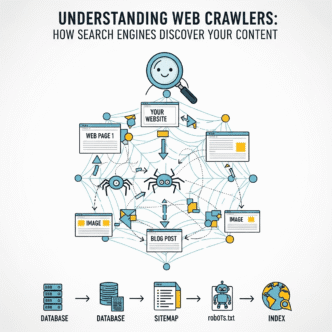Your beautiful desktop website just became irrelevant. While you’ve been perfecting that stunning desktop design and obsessing over how your site looks on a 27-inch monitor, Google quietly pulled the rug out from under you.
Here’s the wake-up call: mobile-first SEO 2025 isn’t coming – it’s already here, and it’s ruthlessly punishing websites that aren’t mobile-optimized. Google doesn’t even look at your desktop version anymore for ranking decisions. Your mobile site IS your website now.
The brutal truth? If your site doesn’t work flawlessly on a smartphone, you’re not just losing mobile users – you’re losing ALL users. Google’s mobile-first indexing has made desktop-centric thinking as outdated as dial-up internet.
Ready to face the mobile-first reality? Let’s dive into why desktop SEO died and how to dominate the mobile-first world.
Table of Contents
ToggleWhat Exactly Is Mobile-First SEO and Why Does It Matter?
Mobile-first SEO is the practice of optimizing websites primarily for mobile devices, with desktop as a secondary consideration. It’s the complete opposite of how we used to think about web design.
Think of it like this: if traditional SEO was designing a house for adults and then trying to squeeze kids into it, mobile SEO is designing for kids first and then scaling up. Everything starts with the mobile experience.
Google’s mobile-first indexing means the search engine giant uses your mobile version to determine rankings, even for desktop searches. Your desktop site could be absolutely perfect, but if your mobile site sucks, you’re toast.
Over 70% of websites are now indexed mobile-first, and mobile devices account for 62.54% of global organic search traffic. These numbers aren’t just statistics – they’re a clear signal that mobile optimization isn’t optional anymore.
Why Did Google Kill Desktop-First SEO?
The numbers don’t lie – mobile search now dominates the internet landscape. Mobile devices drive 64% of global web traffic, and that percentage keeps climbing.
Google’s job is to serve users the best possible results. When the majority of users are on mobile, it makes sense to prioritize sites that deliver excellent mobile experience over those that only look good on desktop.
The shift wasn’t sudden – Google warned us for years. But many businesses kept treating mobile optimization as an afterthought, and now they’re paying the price with tanked rankings and lost traffic.
Pro Tip: “Google doesn’t care how beautiful your desktop site is anymore. The mobile version is the only version that matters for rankings. I’ve seen companies lose 70% of their organic traffic simply because they ignored mobile optimization.” – Senior SEO Consultant
How Does Mobile-First Indexing Actually Work?
Mobile-first indexing flips the traditional crawling process on its head. Instead of Google primarily looking at your desktop site, it now uses your mobile version as the primary source for indexing and ranking.
Here’s what happens: Googlebot Mobile crawls your mobile site first, indexes that content, and uses those signals to determine your rankings across ALL devices. Your desktop rankings are now determined by your mobile site’s quality.
This means mobile usability isn’t just about user experience anymore – it’s a direct ranking factor that affects your entire SEO performance. Poor mobile experience equals poor rankings everywhere.
Google uses mobile-first indexing for 100% of new websites, and as of 2025, sites without mobile accessibility face the risk of becoming non-indexable.
What Are the Critical Mobile SEO Ranking Factors in 2025?
Mobile performance has become the make-or-break factor for SEO success. Google evaluates several key elements when determining mobile rankings:
Page Speed and Core Web Vitals
Mobile users are impatient – they expect pages to load in under 3 seconds. Google’s Core Web Vitals (LCP, INP, CLS) are even more critical on mobile where processing power and connection speeds vary dramatically.
Mobile-friendly design means optimizing for the slowest common denominator, not the fastest. Your site needs to work perfectly on a 3-year-old smartphone with a spotty 4G connection.
Touch-Friendly Interface Design
Responsive design goes beyond just fitting content on smaller screens. Buttons need to be large enough for thumbs, links should be spaced properly, and navigation must work with touch gestures.
Font sizes, tap targets, and spacing all become crucial mobile usability factors that directly impact your rankings and user engagement.
Content Accessibility and Readability
Mobile screens demand different content strategies. Long paragraphs become unreadable walls of text. Complex navigation structures become unusable.
Mobile optimization requires rethinking your entire content strategy, not just shrinking your desktop design to fit smaller screens.
Which Mobile SEO Strategies Actually Work in 2025?
The most effective mobile-first SEO 2025 strategies focus on creating genuinely superior mobile experiences, not just checking boxes.
Progressive Web App (PWA) Implementation
PWAs bridge the gap between websites and mobile apps, offering app-like experiences through web browsers. They load instantly, work offline, and provide smooth, native-feeling interactions.
Companies implementing PWAs see average improvements of 20% in conversion rates and 65% increase in page views per session. The technology has matured enough that it’s becoming essential for competitive mobile search performance.
Accelerated Mobile Pages (AMP) Strategy
While AMP isn’t as dominant as it once was, it still provides advantages for content-heavy sites like news publications and blogs. AMP pages load almost instantly and get special treatment in mobile search results.
The key is implementing AMP correctly – many sites see traffic drops because they create stripped-down AMP versions that hurt user experience instead of improving it.
Voice Search Optimization
Voice search is predominantly mobile, with around 50% of U.S. consumers using voice search every day. Mobile SEO in 2025 requires optimizing for conversational queries and local search intent.
This means targeting long-tail keywords that match how people actually speak, not just how they type. “Best pizza restaurant downtown” becomes “where can I get good pizza near me right now?”
How Do Mobile and Desktop SEO Strategies Compare?
The differences between mobile and desktop SEO strategies are more dramatic than most people realize:
| SEO Factor | Desktop Focus | Mobile-First Approach | Impact Level |
|---|---|---|---|
| Page Speed | 3-4 seconds acceptable | Under 2 seconds required | Critical |
| Content Strategy | Detailed, comprehensive | Scannable, bite-sized | High |
| Navigation | Hover menus, sidebars | Touch-friendly, minimal | Critical |
| Images | High-resolution showcase | Optimized, fast-loading | High |
| Local SEO | Secondary consideration | Primary ranking factor | Critical |
| Voice Search | Not relevant | Essential optimization | Growing |
| User Intent | Research-focused | Action-oriented | High |
Mobile rankings require fundamentally different approaches to content, design, and technical optimization compared to traditional desktop SEO.
What Mobile Optimization Mistakes Are Killing Your Rankings?
Even websites that think they’re mobile-optimized often make critical errors that destroy their mobile search performance.
The Responsive Design Trap
Many sites implement responsive design but fail to optimize the actual mobile experience. Your site might technically “work” on mobile while being practically unusable.
Common issues include tiny text that requires zooming, buttons too small to tap accurately, and content that’s organized for desktop consumption rather than mobile scanning behavior.
Mobile Speed Optimization Failures
Mobile performance requirements are stricter than desktop. Large images, bloated JavaScript, and server response times that seem fine on desktop can destroy mobile user experience.
The biggest mistake is testing only on high-end devices with fast connections. Your site needs to work perfectly on mid-range smartphones with unstable network connections.
Content Strategy Mismatches
Desktop content strategies often fail miserably on mobile. Long-form content without proper breaks becomes unreadable. Complex information architecture becomes unusable.
Mobile usability requires rethinking your entire content approach – how information is presented, organized, and consumed changes dramatically on smaller screens.
Expert Warning: “I see businesses every day that think having a responsive theme means they’re mobile-optimized. That’s like thinking owning a car makes you a race car driver. Mobile optimization requires specific strategies and constant testing.” – Mobile UX Specialist
Common Mobile SEO Pitfalls to Avoid in 2025
Learning from others’ mistakes can save you from costly SEO disasters. Here are the most dangerous mobile SEO pitfalls that are still claiming victims in 2025:
Critical Mobile SEO Mistakes
Ignoring Mobile-First Indexing Requirements: Mobile-optimized sites are 67% more likely to rank on Google’s first page, yet many businesses still treat mobile as an afterthought.
Poor Touch Interface Design: Buttons smaller than 44 pixels, links too close together, and navigation that requires precise finger movements frustrate users and increase bounce rates.
Inconsistent Content Between Versions: Having different content on mobile versus desktop confuses Google’s crawlers and can result in ranking penalties.
Blocking CSS/JavaScript Resources: Preventing Googlebot from accessing critical rendering resources makes it impossible for Google to properly evaluate your mobile site.
Intrusive Interstitials: Pop-ups that cover content on mobile devices are penalized by Google and create terrible user experiences.
Technical Mobile SEO Errors
Missing Viewport Meta Tags: Without proper viewport configuration, your site won’t display correctly on mobile devices.
Unoptimized Images: Images that aren’t compressed or properly sized for mobile slow down page load times dramatically.
Poor Server Response Times: Mobile users on slower connections are disproportionately affected by server delays.
Flash or Unsupported Technologies: Using technologies that don’t work on mobile devices creates broken experiences for users.
Content and UX Mistakes
Hiding Important Content: Collapsing crucial information into accordion menus or hiding it completely can hurt your mobile rankings.
Tiny Fonts: Text smaller than 16px is difficult to read on mobile and creates accessibility issues.
Horizontal Scrolling: Content that requires horizontal scrolling provides a poor user experience and may be penalized.
Complex Forms: Long, complicated forms are particularly problematic on mobile and can kill conversion rates.
Trending AI/SEO Topics Integrated with Mobile-First Strategy
The convergence of AI and mobile SEO is reshaping how we approach optimization in 2025. Understanding these trends is crucial for staying competitive.
AI-Powered Mobile Search Evolution
AI Overviews are reducing website clicks by over 30%, even as visibility increases. This shift requires mobile sites to optimize for featured snippets and direct answers that appear in AI-generated results.
Machine Learning Impact: 51% of marketers use AI tools to optimize their content for search engines. AI is analyzing mobile user behavior patterns to predict what content will perform best on smaller screens.
Voice Search Integration: With AI assistants becoming more sophisticated, 84% of marketers believe that the most effective use case of AI is to align web content with the intent of Google searches.
AI Tools for Mobile SEO Optimization
Modern AI tools are revolutionizing mobile SEO workflows:
Automated Mobile Testing: AI can now simulate thousands of different mobile device configurations to identify optimization opportunities.
Content Adaptation: 67% of people see an improvement in their content quality after using AI when optimizing for mobile consumption patterns.
Performance Prediction: Machine learning algorithms can predict how mobile site changes will impact Core Web Vitals before implementation.
Search Everywhere Optimization
ChatGPT is already ranking as the 5th most visited site globally, with nearly 5 billion visits per month. Mobile sites must now optimize for:
- Traditional Google search
- AI chatbots and search engines
- Voice assistants
- Social media discovery
This “search everywhere” approach requires mobile content that works across multiple AI-powered platforms.
E-E-A-T in Mobile Context
Machine learning/AI, Core Web Vitals, and E-E-A-T (Expertise, Experience, Authoritativeness, and Trustworthiness) now influence global search rankings. For mobile sites, this means:
Mobile-Specific Expertise: Demonstrating understanding of mobile user behavior and needs.
Mobile Experience Signals: Providing evidence of successful mobile user interactions and outcomes.
Mobile Authority: Building authority specifically through mobile-optimized content and user engagement.
Mobile Trust Signals: Implementing security, privacy, and usability features that build trust on smaller screens.
How Can You Test Your Mobile SEO Performance?
Effective mobile optimization requires continuous testing and monitoring using the right tools and metrics.
Essential Mobile SEO Testing Tools
Google’s Mobile-Friendly Test: The basic starting point, but don’t stop here. This tool only checks if your site meets minimum mobile requirements.
Google PageSpeed Insights: Focus on the mobile scores – desktop scores are largely irrelevant now. Pay special attention to Core Web Vitals metrics.
Search Console Mobile Usability Report: Shows real issues Google finds when crawling your mobile site. Fix every issue flagged here immediately.
Google’s Rich Results Test: Ensures your structured data works properly on mobile devices for enhanced search appearances.
Advanced Mobile Testing Resources
For comprehensive mobile SEO analysis, consider these professional-grade tools:
- Google Search Console: Free tool for monitoring mobile indexing status and usability issues
- PageSpeed Insights: Detailed Core Web Vitals analysis for mobile performance
- Mobile-Friendly Test: Quick mobile compatibility checker
Real-World Mobile Testing
Test on actual devices, not just browser resize tools. Different phones, operating systems, and connection speeds reveal issues that desktop testing misses.
Use throttled connections to simulate real-world mobile internet speeds. What loads fine on your office WiFi might be unusable on cellular networks.
Mobile Analytics Deep Dive
Mobile experience optimization requires different metrics than desktop SEO. Monitor mobile bounce rates, time on page, and conversion rates separately from desktop.
Mobile users behave differently – they scan faster, leave quicker, and have different intent patterns. Your analytics should reflect these behavioral differences.
What Does the Future Hold for Mobile-First SEO?
Mobile-first SEO 2025 is just the beginning. The mobile-first world is evolving rapidly, and staying ahead requires understanding emerging trends.
5G and Enhanced Mobile Experiences
5G networks are enabling richer, more interactive mobile experiences. Sites that can leverage faster speeds for enhanced mobile performance will gain competitive advantages.
This means preparing for higher user expectations around loading speeds, interactive content, and real-time functionality on mobile devices.
AI and Mobile Search Integration
Mobile searches are becoming more conversational and context-aware. Mobile search optimization increasingly requires understanding AI-driven search features and voice query patterns.
The integration of AI assistants with mobile search is creating new opportunities for businesses that optimize for natural language queries and local intent.
Mobile Commerce Domination
Mobile devices are projected to generate 75% of eCommerce sales in 2025, making mobile usability even more critical for business success. The line between SEO and conversion optimization blurs when mobile experience directly impacts revenue.
Future mobile SEO strategies will need to balance search visibility with conversion optimization, user experience, and mobile-specific customer journey considerations.
Mobile-First SEO Statistics Dashboard 2025
Comprehensive data analysis showing the dominance of mobile-first SEO
Global Web Traffic Distribution
Mobile SEO Impact Metrics
Mobile vs Desktop SEO Requirements
AI Integration in SEO
Mobile Performance: Target vs Current
Key Insights from Mobile-First SEO Data
Mobile Dominance
64% of global web traffic comes from mobile devices, making mobile optimization non-negotiable.
Ranking Advantage
Mobile-optimized sites are 67% more likely to rank on Google's first page.
AI Integration
51% of marketers use AI tools for SEO, with 67% seeing content quality improvements.
Performance Gap
Most sites still miss mobile performance targets, with load times 37% slower than recommended.
Voice Search Growth
50% of consumers use voice search daily, predominantly on mobile devices.
AI Impact
AI Overviews are reducing website clicks by 30%, requiring new optimization strategies.
Data sources: Google Search Central, Statista, Impact.com, PageOptimizer, Semrush, HubSpot
Charts represent 2025 mobile-first SEO statistics and trends
Statistics That Prove Mobile-First SEO’s Dominance
The data overwhelmingly supports the mobile-first approach:
- Over 70% of websites are now indexed mobile-first
- Mobile devices drive 64% of global web traffic
- Mobile-optimized sites are 67% more likely to rank on Google’s first page
- Mobile devices account for 62.54% of global organic search traffic
- Up to 59.45% of all web traffic globally comes from mobile devices
- 83.58% of Google traffic now comes from mobile devices
These statistics aren’t just numbers – they represent a fundamental shift in how people interact with the internet and how search engines evaluate websites.
Ready to Embrace Mobile-First Reality?
Mobile-first SEO 2025 isn’t a trend you can wait out – it’s the new permanent reality of digital marketing. Desktop SEO didn’t just become less important; it became irrelevant for ranking decisions.
The businesses thriving in this mobile-first world aren’t the ones with the prettiest desktop sites. They’re the ones that recognized mobile users as their primary audience and built everything around delivering exceptional mobile experience.
Your mobile site isn’t just a smaller version of your desktop site – it’s your entire digital presence. Google judges you based on how well you serve mobile users, and mobile users judge you based on how quickly and easily they can accomplish their goals.
The mobile-first revolution happened while most businesses were still thinking desktop-first. The winners are the ones who adapt quickly and completely to this new reality.
Don’t mourn the death of desktop SEO – celebrate the opportunity to dominate mobile search while your competitors are still figuring out that the game has completely changed.
Final Thoughts and Verdict
The evidence is overwhelming: mobile-first SEO isn’t just the future – it’s the present reality that’s already determining winners and losers in search rankings. Over 70% of websites are now indexed mobile-first, and mobile devices drive 64% of global web traffic. These numbers tell a clear story: adapt to mobile-first or become irrelevant.
The integration of AI into mobile search adds another layer of complexity and opportunity. 51% of marketers use AI tools to optimize their content for search engines, and ChatGPT is already ranking as the 5th most visited site globally. This convergence of mobile and AI search means businesses must optimize for multiple platforms while maintaining mobile-first principles.
The Verdict: Mobile-first SEO isn’t optional in 2025 – it’s the foundation of all successful digital marketing strategies. Companies that continue to prioritize desktop experiences while treating mobile as secondary will find themselves increasingly invisible in search results. The future belongs to businesses that think mobile-first, design mobile-first, and optimize mobile-first.
Success in this mobile-dominated landscape requires more than just responsive design. It demands a fundamental shift in how you approach content creation, user experience design, and technical optimization. The tools and strategies are available – the question is whether you’ll implement them before your competitors do.
Final Reality Check: The mobile-first world rewards speed, simplicity, and user-centric design over flashy desktop experiences. Your mobile site is your business card, your storefront, and your sales team all rolled into one. Make it count.
Time to stop optimizing for how YOU browse the web and start optimizing for how your CUSTOMERS actually use the internet. Welcome to the mobile-first future – it’s been waiting for you.
Frequently Asked Questions
What is mobile-first indexing and how does it affect my website?
Mobile-first indexing means Google primarily uses the mobile version of your website’s content for indexing and ranking, even for desktop searches. Google uses mobile-first indexing for 100% of new websites. If your mobile site is poorly optimized or missing content, it will hurt your rankings across all devices.
How do I know if my website is mobile-friendly?
Use Google’s Mobile-Friendly Test tool to get an initial assessment. However, being “mobile-friendly” is just the baseline. You should also check your Core Web Vitals scores, test on actual devices, and monitor your Search Console for mobile usability issues. Mobile-optimized sites are 67% more likely to rank on Google’s first page.
What are the most common mobile SEO mistakes businesses make?
The biggest mistakes include: treating mobile as an afterthought, having different content on mobile vs desktop, poor touch interface design with tiny buttons, slow page load speeds, intrusive pop-ups, and not optimizing for voice search. Many businesses also fail to test their sites on actual mobile devices with real network conditions.
How does AI affect mobile SEO in 2025?
AI is transforming mobile SEO in several ways: AI Overviews are reducing website clicks by over 30%, voice search is becoming more sophisticated, and 51% of marketers use AI tools to optimize their content for search engines. Mobile sites must now optimize for AI-generated answers, voice queries, and multiple search platforms beyond traditional Google results.
What’s the difference between responsive design and mobile optimization?
Responsive design makes your site technically viewable on mobile devices by adjusting layout and sizing. Mobile optimization goes much deeper – it includes responsive design plus mobile-specific content strategy, touch-friendly interface design, mobile page speed optimization, and mobile user experience considerations. Many sites are responsive but not truly mobile-optimized.
How important is page speed for mobile SEO?
Page speed is critical for mobile SEO. Mobile users expect pages to load in under 3 seconds, and Google’s Core Web Vitals are major ranking factors. Mobile connections are often slower and less stable than desktop, making speed optimization even more important. Use tools like PageSpeed Insights to monitor and improve your mobile loading times.
Should I create a separate mobile website or use responsive design?
Google strongly recommends responsive design over separate mobile sites (m.domain.com). Responsive design is easier to maintain, avoids duplicate content issues, and provides a consistent URL structure. Separate mobile sites can work but require careful implementation to avoid SEO problems and maintain content parity.
How do I optimize for voice search on mobile?
Voice search optimization for mobile involves targeting conversational, long-tail keywords that match how people naturally speak. Focus on local intent (“near me” searches), question-based keywords, and featured snippet optimization. Around 50% of U.S. consumers use voice search every day, making this optimization crucial for mobile success.
What are Core Web Vitals and why do they matter for mobile?
Core Web Vitals are Google’s user experience metrics: Largest Contentful Paint (LCP) measures loading speed, Interaction to Next Paint (INP) measures interactivity, and Cumulative Layout Shift (CLS) measures visual stability. These metrics are especially important on mobile where users have less patience and processing power varies significantly across devices.
How often should I test my mobile SEO performance?
Monitor your mobile SEO performance continuously through Google Search Console and analytics. Conduct comprehensive mobile audits monthly, test on actual devices weekly, and check Core Web Vitals regularly. Set up alerts for mobile usability issues and monitor how mobile algorithm updates affect your rankings. Mobile SEO requires ongoing attention, not one-time optimization.














